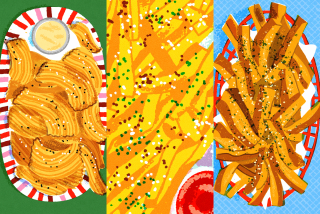The Portuguese Connection
- Share via
England and Japan have a lot in common. For instance, they’re both known for very formal social manners and, at the same time, for their love of nature.
And England and Japan are both fond of deep-fried batter-coated fish: fish and chips and tempura, respectively. Could this, like their shared taste for plain cooking, be another consequence of being island nations?
No, it’s simpler than that. Both countries picked up the recipe from Portuguese visitors in the 16th and 17th centuries.
It’s pretty well known that Portuguese merchants introduced tempura to Japan. They were in the habit of eating fried fish during the religious seasons (tempora) of abstinence from meat. Deep frying had been a standard way of cooking fish in Spain and Portugal for hundreds of years, as we know from the recipes for fried fish in egg batter that appear in 13th-century Spanish Arabic cookbooks.
But it’s not so well known how batter-fried fish became part of the English diet. It was brought by Portuguese Jews escaping the Inquisition. Having fled first to the Netherlands, they went on in the 16th and particularly the 17th centuries to England, where their religious freedom was assured.
“Jewish fried fish” (which was originally served cold, by the way) was admired by 19th-century English food writers, and even Thomas Jefferson developed a taste for it; a recipe shows up in his personal recipe collection. There were a lot of fried-fish stands in 19th-century England. The combination of fish and chips arose in the 1860s, after Irish immigrants introduced the fried potato shop to London.


